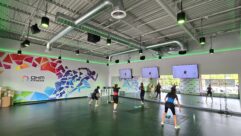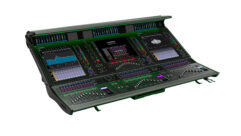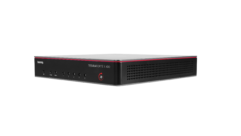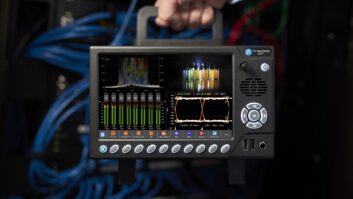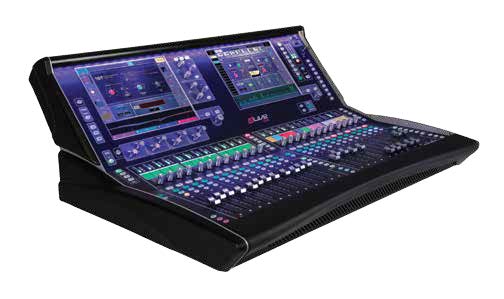

The Allen & Heath dLive C3500 distributed digital mixing system is designed for live sound and it’s the largest C Class control surface for the dLive MixRack. The operator controls are fully customizable with every input or mix assignable to any bank or layer. There are also 19 assignable SoftKeys, plus three pages of six assignable rotaries, highgrip rotary knobs with RGB illumination, and the familiar twin 12in. capacitive touchscreens. It also features USB stereo recording and playback, six XLR mic/line inputs with six XLR line outs, and AES digital input and output.
At the other end of the application spectrum, the Alero ALR-AEC-8 from AMX can auto-mix up to eight microphones for web conferencing in medium to large conference rooms.
The unit also has a USB port that can be used for Enzo or PC-based web conferencing applications. Its features include noise reduction to decrease hiss or static, acoustic echo cancellation to eliminate feedback, and automatic gain control to keep output within a good range with participants speaking at varying levels. The simple onboard web configuration tool requires no PC software.

Ashly Audio has a big mixer in a small package with the digiMIX24. The mixer features USB interfacing and a large touchscreen along with a companion iPad app. The Live Motorized Fader can be assigned to any input while the Intelligent Meter Bridge displays all fader positions and signal levels. For church environments where volunteers with little technical experience are working, there is also an EZ-Mode for the Ashly digiMIX iPad App. The USB port can be used for multi-track recording and network audio capability can be added with the Dante module.

Audio-Technicamakes it easy to switch from automatic to manual mixing with the compact, five-input AT-MX351a, and it adds a headphone monitor output with its own level control. Multiple units can be cascaded with channel priority extending through the whole chain. Each input is mic/line selectable and has switchable 48V phantom power. There are pre- or post-controller audio outputs, contact closure remote control, master gain, individual channel limiters, and an output level meter with peak and RMS modes. All of these features are housed in a single rack unit.

The new TesiraFORTÉ DAN audio processors are the collaborative result between Biamp and Shure. Offered in the same four fixed I/O models as the original TesiraFORTÉ family (AI, CI, TI, and VI) with the addition of 32×32 channels of audio via the Dante Brooklyn II module. All models are standard with 12 mic/line inputs, eight line outputs, Ethernet control, RS-232, USB audio with up to 8 channels of configurable audio, four general purpose I/Os, and an OLED display. The TesiraFORTÉ DAN VI, TI, and CI models feature Biamp’s AEC technology to eliminate acoustic echoes and feedback for a clear, natural-sounding audio experience. Along with the new dedicated Shure MXA input blocks in the latest Tesira 3.0 software, these new processors deliver seamless interoperability between the most advanced DSP and microphone technologies.

The PLM-8M8 PLENA matrix 8-channel DSP mixer from Bosch Security Systems connects to PLM8CS call stations, PLMWCP wall control panels, and the PLM4Px2x amplifiers to create up to eight zones for speech and background music. Managed through PC GUI or an iOS app, the unit has input gain, compression, EQ, output delays, and both zone and global system muting. Drag-and-drop makes the copying of these parameters to other zones very quick and easy. The PLM8CS call station and PLMWCP wall control panel can be connected in series using RS485.

The Cadac CDC seven uses 36 faders to control 96 inputs on 56 buses (48 configurable) and each fader channel has above it a full color user definable OLED display. There is a 64×64 Waves SoundGrid interface and 20 segment stereo channel metering along with eight fully programmable line inputs and outputs. User customization is paramount using the dual 23.5in., 16:9 high-definition LCD touchscreens. All Cadac digital audio is transmitted using Cadac’s proprietary MegaCOMMS digital interconnect protocol, which minimizes latency.

For conferencing applications ClearOne has the CONVERGE SR1212A a 12×12, automatic digital matrix mixer with a builtin 4-channel power amp at 35W each into 8Ω or 70V/100V speaker systems and D.A.R.E (Dynamic Automatic Resonance Elimination) for feedback control. There is also an expansion bus, 10 mic gating groups, event scheduler, and diagnostic console. Remote management options include an SNMP and HTTP interface. Units can be linked to provide 96 microphones and up to 16 phone lines, while automatic gain and level controls allow AudioTechnica AT MX351a Biamp Systems TesiraFORTE DAN AI Bosch PLENA PLM-8M8 Cadac CDC seven 20 SVC | JUNE 2017 | SVCONLINE.COM TECH SHOWCASE hands-free operation.

The new Tactus Digital Mixing System from Crest Audio begins with eight inputs in the Tactus FOH and goes to 32-inputs in the Tactus Stage. These can be cascaded for up to 256 channels. Tactus Control can add a physical fader desk and it functions as a physical extension of the Waves eMotion LV1 software.

The DS10 Audio Network Bridge from d&b audiotechnik enables distribution of Ethernet control data and it connects Dante networks and AES3 digital audio signals. Up to 16 Dante network channels can be provided via AES3 digital signal outputs conveying metadata with Dante channel labels and cabling information to the 4-channel d&b amplifiers, and there are four AES3 input channels as well. The unit handles a primary and a secondary redundant Dante network on a fiveport switch and it has Multicast Filtering and VLAN modes. A laptop can control d&b amplifiers using the R1 Remote control software.

DiGiCo designed the SD12 for live sound, theater, and broadcast with 72 inputs, 36 aux/sub-group busses and a 12×8 full-processing matrix. The operator surface features two 15in. Wideview touchscreens, quickselect function buttons, two solo busses, new LED meters, and the Lightbar from the SD5 and SD7 consoles. The mixer also has 100mm motorized faders, graphic EQ, internal FX, user defined presets, phase reverse, and a host of other parameter controls. The system also provides eight local mic/line inputs and eight line outputs.

The Electro-Voice N8000 NetMax 300 MIPS digital matrix controller delivers full IRIS-Net supervision, control, and scheduling along with up to 32 input channels, extensive DSP and CobraNet audio and control connections. Four slots with 8-channel audio modules form the foundation for flexible customization, and each slot can house input or output cards. One time or regularly scheduled events can be arranged and reactions to certain events or system states can be configured. Any system problems can be detected automatically and can be displayed on the PC screen or transmitted to external sites.

The DMP 128 Plus Series digital matrix processors from Extron feature 12 analog mono mic/line inputs, eight analog outputs, up to 4 channels of digital audio input, and output via USB, up to eight audio file players, an ACP bus for audio control panels, and configurable macros. The DMP 128 Plus AT models are Dante equipped and they can be interconnected to expand input/output capability. The DMP 128 Plus C V and DMP 128 Plus C V AT models include up to eight lines for VoiP configuration. The DSP Configurator software makes setup and management very easy.

Lectrosonics had versatility in mind when it developed the Aspen SPN2412 with its 24 inputs and 12 outputs, which can be expanded to many more. The Proportional Gain Algorithm allows it to work seamlessly with other sound gear, while data, audio, and control signals are carried through a single Cat-6 cable. Setup is aided by automatic master/slave detection and its automatic mixing parameters and presets are extensive including multi-zone mix minus configuration. The Phantom Mix mode lets the mixing come from multiple zones and fed back into only those zones that are selected for the feed.

The 32-channel Mackie DL32R is built road-tough and its Onyx+ mic pres deliver clear sound to the mixer’s 14 assignable XLR outputs, stereo AES, phones out, and 1/4in. monitor output. The DL Dante expansion card provides an optional 32×32 channels of networked audio. The DL32R is based on the Mackie AXIS Digital Mixing System and the Master Fader control app allows wireless control with View Groups, overview, user definable presets, and mic preamp view. Sophisticated DSP and 32 track recording to disk, computer or any Dante equipped recording device provide plenty of creative power.

The fully expandable DR16 features Peavey’s Silencer mic preamps on eight of its inputs and it includes Mid-Morph EQ, a parametric EQ, a 31-band graphic EQ, and an automatic feedback eliminator. The DR16 can handle up to 10 Ethernet and four Wi-Fi connections, and the Wi-Fi can be used by the Peavey app (available for iOS/Android/Mac/ PC) for control from the stage or house.
Presonus designed the StudioLive 32with touch-sensitive motorized faders, AVB networking, and 33 recallable XMAX preamps. It also features onboard multitrack capture recording to SD Card, virtual soundcheck, and a complete suite of software to access all of its capabilities. Laid out for the operator’s hand, the mixer includes vintage-style EQ and compression options on every channel along with six-band, fully parametric EQ on all mix outputs. Added to this are RGB Select buttons with user-assignable colors and eight user-assignable buttons for mute groups and scenes.

Recently introduced by QSC, the Q-SYS Core 510i uses a QSC-developed Linux realtime operating system (RTOS) and with cardbased I/O as well as native Q-LAN network channel and AES67 features. It can be configured in Q-SYS Core mode for full Q-SYS audio, video, and control including built-in acoustic echo cancellation (AEC) or in I/O Frame mode as a peripheral fitted with various combinations of Q-SYS analog, digital, and networked audio I/O cards. The system provides multiple levels of system redundancy for custom configuration to suit a wide range of operational environments.

The M-5000 Series mixing consoles from Roland apply its OHRCA (Open High Resolution Configurable Architecture) to provide 128 freely definable audio paths. The mixers have expansion modules for Dante, MADI, Waves Soundgrid, REAC, XI-SDI, XI- SFP, and XI-DVI. Its patchbays can accommodate hundreds of input/output channels enabling any input to be routed to a range of outputs without using a mixing channel. The M-5000 has 24 plus 4 faders while the slightly smaller M-5000C uses 16 plus 4 faders. The operation is focused on a bright 12in. touchscreen with 16 encoders having rings that change color according to their assigned functions.

Just introduced at ISE this year, The Shure IntelliMix P300 conferencing processor handles up to eight Dante microphone channels and a USB soft codec or mobile device. Each input channel can be auto-mixed and provides acoustic echo cancellation (AEC), noise reduction, automatic gain control, matrix mixing, delay, compressor, and PEQ. An additional 3.5mm connection enables attendees to join by tablet or phone and all this fits into a half-rack space package. It connects to room systems through two input and two output terminal blocks while its Ethernet connection can use PoE to eliminate a separate power supply.


At the top of the line of the Soundcraft Si Expression series, the Si Expression 3 provides 30 plus 2 faders and 32 mic/line inputs. Four internal stereo FX returns, AES in, and a 64×64 expansion slot provide plenty of versatility while the 14 aux/group mixes can be configured in mono, stereo, or any combination of both. There is a compressor, four band EQ, BSS graphic EQ, and delay on each bus mix. All Si Expression consoles integrate four stereo Lexicon FX processors based on the MX400. With all of these features the mixers maintain the ease of operation throughout the product line for which Soundcraft has come to be known.
Symetrix meets Dante in the Prism line of audio processors with 64×64 channels along with Ethernet and ARC ports to connect touchpanels and wall controllers. Prism 8×8, 12×12, and 16×16 models fit into a single rack space and their embedded Web server allows remote status monitoring and control. The newly designed black front panel has a white on blue 256×64 pixel OLED display. The display shows unit name, IP address, MAC address, Site File version fault messages and additional information. The non-volatile program memory provides program security should power fail and the realtime clock can facilitate automatically timed preset changes.

From TOA Electronics, the D-2000 Digital Mixing System consists of up to four D-2008SP frames, each of which can support up to 32 input channels using eight module slots. These may be connected to remote control units to suit the venue size. The D-2008SP can be linked via LAN to the D-2012C mixing console with 12 motorized faders and eight rotary encoders. A wide variety of analog and digital input and output modules make customization easy. The D-900 Remote Controller can operate up to 12 inputs and eight outputs through its connection to the D-984VC remote control module. Features include NOM automixing, feedback suppression, delay, high and low pass filters, gates, and many more DSP capabilities.

The YamahaMRX and MTX processors have recently added a new tool with MTX/ MRX V3, bringing the power of the Dan Dugan automixer functionality to the whole line. The Dugan system allows more room gain without feedback and it is especially useful on panel discussion formats. The Yamaha MTX3 can use up to 4 channels of Dugan automatic mixing, and the MTX5-D can be used with up to 8 channels of it for a single room or a maximum of four independent Dugan auto-mix channels apiece when in a multi-room setup. This feature on the MRX7-D has been increased from 16 to 24 channels.





